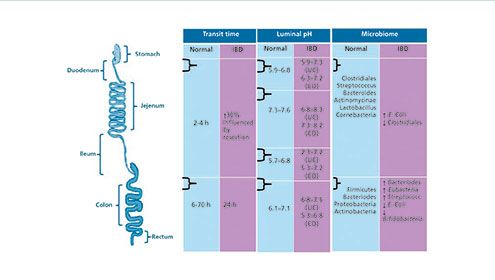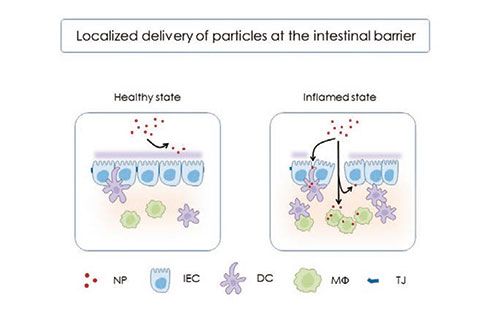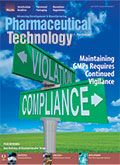Oral Delivery of Macromolecular Drugs
Macromolecular drugs are typically injected, but oral dosage forms are being developed to improve the treatment of gastrointestinal conditions such as inflammatory bowel disease.
westudio/www.shutterstock.com

Small-molecule drugs in oral solid-dosage forms are considered the first line of defense in treating diseases of the gastrointestinal (GI) tract, which affect millions of patients around the world each year. A number of patients, however, either do not respond to these drugs or experience side effects from these drugs.
Macromolecular drugs, such as peptides, proteins, and antibodies, offer a newer class of drugs that can treat diseases of the GI tract, such as inflammatory bowel disease (IBD). These drugs have demonstrated improved efficacy and represent a new paradigm of treatments for IBD.
Macromolecular drugs are usually injected subcutaneously or intravenously, and only a fraction of the administered dose reaches the disease sites in the GI tract. There has been tremendous amount of research to capitalize on the potential benefits of oral delivery macromolecular drugs, which include:
- Better patient acceptance and adherence
- More convenient dosing, including patient self-dosing
- An improved therapeutic profile.
This article reviews current treatment options, analyzes the knowledge and technology gaps that have prevented development of more oral macromolecule dosage forms so far, and discusses some approaches that are being tried and could be used in the future to overcome these gaps.
Inflammatory bowel disease (IBD) is a chronic inflammation of the gastrointestinal (GI) tract that is mediated by the host immune system and is prevalent in Western countries (1, 2). In Europe alone, approximately three million individuals are estimated to have IBD (3).
IBD can be subdivided into two types: Crohn’s disease and ulcerative colitis. Inflammation seen in Crohn’s disease spreads deep into tissues and involves the small intestine, large intestine, or both. Patients with Crohn’s disease may have multiple, non-continuous areas of inflammation. Therefore, the drugs must be available at different points in the GI tract.
Ulcerative colitis causes inflammation in the innermost lining of the large intestine and rectum. Treating patients with ulcerative colitis requires drugs that are protected and released in the distal portion of the GI track. IBD patients suffer from mild to severe symptoms comprising diarrhea, abdominal pain, malnutrition, and an increased risk of colorectal cancer development.
In-vitro and in-vivo IBD models
IBD pathogenesis is multi-factorial; therefore, current in-vitroas well as in-vivoexperimental models attempt to address each of the critical elements associated with IBD. Various in-vitrocell-based models are available to mimic the human intestinal mucosa by simplifying the physiological complexity and, thus, allowing the controlled analysis of discrete cell-cell or cell-molecule interactions. Static cultures of intestinal epithelial cells (IECs) are made of one or more cell lines that originate from human colon carcinoma (e.g., enterocyte-like Caco-2 or goblet-like HT29). A more complex 3D co-culture model mimics the intestinal barrier through a co-culture of IECs with immune cells such as macrophages and dendritic cells (4). The addition of pro-inflammatory mediators leads to an inflammatory microphysiological environment with impaired epithelial barrier function and immune cell activation.
3D modeling of stem cell cultures
Another approach to study IBD conditions is the near-physiological 3D model of epithelial organoid cell (EpOC) culture derived from isolated human intestinal stem cells. As an important bridge between the traditional 2D cell cultures and in-vivo animal models, EpOCs could serve as a platform with which to screen various therapies for a personalized medical application.
Because the gut microbiota of IBD patients is altered regarding composition and metabolic activity, the newer model has been developed to analyze the interaction of potential therapeutics with gut bacteria. The simulator of human intestinal microbial ecosystem (SHIME) is a dynamic in-vitro model used to study of the entire GI tract comprising diverse microbial communities.
The pathogenesis and etiology of human IBD have been studied in various animal models that reflect the complexity of the whole organism (5,6). The most widely used animal model, dextran sodium sulfate (DSS) colitis model, is characterized by a loss of epithelial barrier function and the subsequent entry of luminal bacteria into the mucosa.
Factors that affect drug targeting of the colon can be generalized into pre- and post-absorption challenges (5). Typical pre-absorption challenges include the avoidance of drug absorption and/or degradation in the upper gastrointestinal tract, absorption surface area, mucosa permeability, bile contents, presence of food, and specialized structures such as the Peyer’s patches and lacteal ducts. Post-absorption factors to be considered include potential enzymatic degradation existing in the gut wall and the hepatic first-pass effect.
Inter-population differences in gastric functioning and physicochemical characteristics of gastric fluids also impacts drug disposition further down the GI tract (6). Physiological variations such as differences in the transit time, luminal pH, and microbiome in healthy populations versus IBD patients also influence oral drug absorption (Figure 1) (6,7).
Figure1: Physiological differences between gastrointestinal (GI) tracts of healthy and inflammatory bowel disease (IBD) patients.

IBD and unmet medical need
To date, no cure for IBD exists, and, in severe cases, surgical intervention is inevitable. There is an unmet medical need for novel drugs, and more specific anti-inflammatory approaches, to treat refractory or intolerant IBD patients.
Several therapeutic strategies are currently available to reduce the intestinal inflammation, each one targeting a different site in the GI tract (Table I) (8 –10). Classical treatments for IBD include the use of anti-inflammatory and immunomodulatory drugs such as mesalazine, aminosalicylates, corticosteroids, antibiotics, probiotics, and immunosuppressants such as cyclosporines (8, 9, 11).
[CLICK TO ENLARGE]

Biological therapies have also been developed to target specific IBD pathways. Monoclonal antibodies may be used, for example, to block, selectively, such pro-inflammatory cytokines as tumor necrosis factor- (TNF). In addition, anti-cell-adhesion antibodies such as integrin blockers may be used to help inhibit lymphocyte migration to the gut. However, these biological agents are not effective for all patients with IBD and may increase the risk of infection and the potential for immunogenicity.
A newer strategy focuses on inhibiting signaling by using small molecules to transport Janus kinase (Jak) inhibitors, which can block numerous key cytokines associated with IBD, simultaneously. Unfortunately, these new treatments pose safety questions. Clinical trials are currently exploring more selective targeting of single Jak inhibitors, for example, using RNA interference (RNAi) via synthetic siRNA, to downregulate Jak expression in a specific manner. Advanced drug-delivery strategies are indispensable to successfully deliver siRNA to the target tissue or cells.
So far, FDA has approved two anti TNF antibodies, Infliximab and adalimumab, to treat moderate-to-severe active Crohn’s disease or ulcerative colitis. Because they are biologics, both drugs are administered by injection. Infliximab requires intravenous infusion on weeks zero, two, and six, and then every eight weeks. Adalimumab is administered as a subcutaneous injection on Days 1, 15, and 29, then every other week. Both treatments pose the risk of adverse effects (12). Ustekinumab is another monoclonal antibody indicated for the treatment of moderate to severe Crohn’s disease, which targets IL-12 and IL-23 cytokines. The initial dose is administered as an intravenous infusion and is followed by maintenance therapy of a subcutaneous injection every eight weeks.
Oral delivery of macromolecule drugs
Being able to deliver macromolecular IBD treatments orally would improve patient experience, avoid systemic exposure, and increase drug presence at disease sites. However, maintaining stability and activity in the GI is a significant challenge. So far, in studies that have evaluated the potential for oral delivery (13 – 16), considerable variability has been seen in the recovery, stability, and activity of orally administered macromolecules.
Clinical trials of target oral therapies for IBD have also shown insufficient results. One case in point is Mongersen (GED0301), a 21-base single-strand antisense oligonucleotide that complexes to Smad7 mRNA to cause degradation via the classical antisense pathway (17) to restore the function of TGF-1’s anti-inflammatory actions. The compound was tested in modified-release film-coated tablets using methacrylic acid-ethyl acrylate copolymers as a pH-dependent coating. The target treatment areas were the lumen of the terminal ileum and right colon. However, results were inconclusive, and clinical trials were discontinued in October 2017.
Another compound undergoing clinical trials is AVX-470, a novel polyclonal anti-TNF antibody candidate isolated from bovine colostrum, whose in-vitro activity is similar to that of infliximab (13). Disease severity was reduced when the murine version (AVX-470m) was orally administered in mouse models of IBD. Minimal systemic exposure was seen in mouse models.
A Phase I placebo-controlled study in 36 ulcerative colitis patients assessed the safety, pharmacokinetics, immunogenicity, and efficacy of four weeks of treatment (18). Clinical response was seen in 25.9% of patients and only treated with the candidate therapy, compared to 11.1% of the patients who received the placebo.
Formulation and dosage-form considerations
In addition to addressing stability, to ensure that the drug remains in the GI tract long enough to be effective, targeted delivery to the colon is the greatest challenge for developing oral therapies for IBD. Most current approaches use an enteric coating system to protect the drug and only release it at target sites. However, each IBD patient has a different disease profile, so a formulation that, for example, releases in the colon will not help a patient whose IBD affects the small intestine.
Ensuring sufficient residence time in the GI tract will require use of a toolbox of technologies and approaches that are designed to enhance the predictability and reproducibility of targeting of the drug in the colon.
Use of pH-sensitive polymers. Once the macromolecule is exposed to the environments of the small and large intestines, proper formulation and dosage form design can help ensure that it retains activity. One formidable challenge is to protect the macromolecule from the acids that are secreted by the stomach until the dosage unit reaches IBD sites in the intestines.
Use of a coating system can help control the release the macromolecule at specific pH points. One of the approved therapies for IBD, the small molecule, mesalazine, use different grades of Eudragit polymers to achieve specific release profiles. Even though this example is a small molecule, the principle of using coatings for controlled release could also, in theory, work for larger molecules, as was shown in clinical trials (e.g., for mongersen).
Biodegradable polymers. Biodegradable polymers, known for their low toxicity and biodegradability, have been extensively used to formulate GI tract treatments that target the lower GI tract. Within the colonic environment, these mostly hydrophilic polymers can be broken down by various bacteria (19) for a controlled release of the drug within the colon. These polymers can be combined or used individually to modulate the rate of drug release and absorption (19). Options include guar gum, pectin, chitosan, chondroitin sulfate, galactomannan, and amylose, all of which are categorized as “generally regarded as safe” (GRAS).
Mucoadhesive systems. Mucoadhesive systems have been designed to increase the time that the formulation is retained within the GI wall in order to increase absorption of poorly absorbable drugs or improve their topical application (20). Some of the better-known mucoadhesive polymers include polycarbophils, polyurethanes, and polyethylene oxide.
Multiparticulate systems. Although most efforts to develop oral dosage forms for GI therapies focus on capsules or tablets, this approach may not allow the drug to be adequately released at all disease sites throughout the small and large intestines.
Nanoparticle-based delivery
Using multiparticulates, formulating dosage units with different coating systems may be more efficient. The size of the pylorus is known to be around 7–8 mm when a patient is fasting, decreasing to 2–3 mm after a patient has eaten. Multiparticulate dosage units smaller than 2–3 mm in diameter would be able to leave the stomach, whether the patient was in a fasting or fed state.
Nanoparticles. Micro- and nano-particles represent novel approaches to localized delivery. Taking advantage of the GI tract’s leaky epithelial barrier, these particles tend to accumulate in inflamed portions of the GI tract, optimizing drug delivery. In murine models and first-in-human clinical trials, nanoscale particles were found to accumulate in inflamed areas (21).
Smart delivery of nano-scale systems takes advantage of the physiological homing mechanisms to the site of injury and inflammation (Figure 2), and nanotechnology is an area of intense research and development for GI-tract therapies that target the colon (22).
Figure 2: Pathophysiological changes during intestinal inflammation facilitate particle accumulation inside the inflamed tissue. Abbreviations: nanoparticles (NP), intestinal epithelial cells (IEC), dendritic cell (DC), macrophage (MΦ), tight junction (YJ).

Other options for controlled and targeted release include prodrugs, embedding the drug in a matrix, and using osmotic control for delivery. Ultimately, the choice of delivery system depends on many factors, including target product profile. Table II lists the pros and cons of a number of available technologies.
[CLICK TO ENLARGE]

Conclusion
Small-molecule drugs have been the treatment of choice for IBD, but a large percent of patient eventually don’t respond the therapy. Macromolecular drugs are a newer class of drugs that have improved efficacy and require injection. Researchers are studying oral delivery approaches for macromolecular drugs that have better patient acceptance and adherence, more convenient dosing, and an improved therapeutic profile. Before patients can benefit, researchers must address the technology gaps that have prevented development of more oral macromolecule dosage forms.
References
1. Magro F., et al., J Crohns Colitis. 7(10):827-51 (2013).
2. Coward S, Kaplan GG, IBD in the New World, Old World, and Your World. Inflammatory Bowel Disease: p. 13-27 (Springer; 2017).
3. Molodecky NA, et al, Gastroenterology. 142(1):46-54 e42; quiz e30 (2012).
4. Susewind J, et al. Nanotoxicology, 10(1):53-62 (2016).
5. Non-invasive Macromolecule Drug Delivery Guide: Catalent Applied Drug Delivery Institute (2015), drugdeliveryinstitute.com
6. Van Den Abeele J, et al. Eur J Pharm Sci.96:207-31(2017).
7. Nalle SC, Turner JR. Mucosal Immunol.8(4):720-30 (2015).
8. Asacol® HD [package insert]. Proctor & Gamble Pharmaceuticals, Inc., Cincinnati, OH; April 2009, accessdata.fda.gov
9. Asacol® [package insert]. Warner Chilcott (US), LLC, Rockaway, NJ; May 2015, accessdata.fda.gov
10. Lautenschlager C, et al. Adv Drug Deliv Rev.71:58-76 (2014).
11. Triantafillidis JK, Merikas E, Georgopoulos F. Drug Des Devel Ther. 5:185-210 (2011).
12. Maurer JM, et al. Int J Pharm. 505(1-2):175-86 (2016).
13. Bhol KC, et al. Inflamm Bowel Dis. 19(11):2273-81 (2013).
14. Jasion VS, Burnett BP. Nutr J. 14:22 (2015).
15. Tonelli F, Giudici F, Asteria CR. Dis Colon Rectum. 55(8):870-5 (2012).
16. Brod SA. J Neurol Sci. 361:19-25 (2016).
17. Monteleone G, et al. N Engl J Med. 372(12):1104-13 (2015).
18. Harris MS, et al. J Crohns Colitis. 10(6):631-40 (2016).
19. Rajpurohit H, Sharma P, Sharma S, Bhandari A. Indian Journal of Pharmaceutical Sciences. 72(6):689-96 (2010).
20. Varum FJ, et al. Critical reviews in therapeutic drug carrier systems. 25(3):207-58 (2008).
21. Schmidt C, et al. J Control Release. 165(2):139-45 (2013).
22. Amidon S, Brown JE, Dave VS. AAPS PharmSciTech. 16(4):731-41 (2015).
Article Details
Pharmaceutical Technology
Vol. 42, No. 7
July 2018
Page: 32–40
Citation
When referring to this article, please cite it as R. Savla, O. Hartwig, W. W. L. Chin, B. Loretz, and C.M. Lehr, “Oral Delivery of Macromolecular Drugs" Pharmaceutical Technology 42 (7) 2018.
About the Authors
Ronak Savla* is scientific affairs manager at Catalent Pharma Solutions, Somerset, NJ, ronak.savla@catalent.com; Olga Hartwigis a PhD student at the Helmholtz-Institute for Pharmaceutical Research Saarland (HIPS), Saarbrücken, Germany; William Wei Lim Chinis a technical specialist, science and technology, at Catalent Pharma Solutions, Eberbach, Germany; Brigitta Loretzis a scientist, at HIPS; and Claus-Michael Lehris head of the drug delivery department at HIPS.
*To whom all correspondence should be addressed.

Drug Solutions Podcast: A Closer Look at mRNA in Oncology and Vaccines
April 30th 2024In this episode fo the Drug Solutions Podcast, etherna’s vice-president of Technology and Innovation, Stefaan De Koker, discusses the merits and challenges of using mRNA as the foundation for therapeutics in oncology as well as for vaccines.